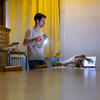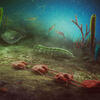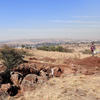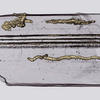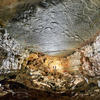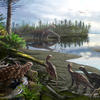You are here
How Jurassic Park changed the image of dinosaurs

Have Michael Crichton’s novel (1990) and the Jurassic Park film saga had an influence on your scientific careers?
Jean-Sébastien Steyer1: In 1993, when Steven Spielberg’s first movie was released, there was such a furore about it that I decided not to go! Years later I finally saw it, and I had a real shock, like everyone else, watching those majestic creatures on the screen. It gave me the thrills, and it still sent shivers down my spine when I saw the film again in preparation for the book. It’s exciting to see non-avian dinosaurs (not members of the bird class – Editor’s note) resurrected thanks to Michael Crichton’s brilliant and quite credible premise: the recovery of dinosaur DNA contained in a prehistoric mosquito trapped in amber. While it has not had a direct impact on my scientific career, Jurassic Park has influenced my work in the dissemination of knowledge.
Jean-Philippe Uzan2: I wouldn’t say that Jurassic Park has had an impact on my scientific career – on my career as a father, perhaps! But the franchise revived an interest in dinosaurs among children, inspiring many of them to take up science. My own son is now studying animal ecology – who knows to what extent his choice was influenced by these films?
How has Jurassic Park revitalised the image of the ‘terrible lizards’?
J-S. S.: The franchise fits in with a new palaeontological paradigm called the ‘dinosaur renaissance’. From the time of their discovery in the 19th century to the middle of the 20th, dinosaurs, exemplified by the Crystal Palace sculptures3, were perceived as slow, clumsy, dumb animals, ill-adapted to their environment. Then in the 1960s and 1970s, two North American palaeontologists, John Ostrom and Robert Bakker, updated the image of these creatures, presenting them as agile, intelligent and hyperactive – and even warm-blooded, like birds. Later studies in comparative anatomy, bone palaeohistology and phylogenetics have established the kinship of dinosaurs and birds, to the point that Tyrannosaurus rex is now known to be more closely related to the pigeon than it is to the Diplodocus.
The Jurassic Park saga depicts this new paradigm in a number of scenes. In the first movie, the palaeontologist Alan Grant warns the children that ‘the T. rex’s vision is based on movement’, which we know from the size and position of its eye sockets as well as the reconstitution of its endocranium. And the third instalment (2001) emphasises interspecies communication, proof of the dinosaurs’ social nature.
Would you say that these fictional works offer a realistic portrayal?
J-S. S.: No – it’s rather the role of palaeontologists to represent dinosaurs realistically, by cross-referencing physiological and behavioural data, etc. Someone taking the time to produce a scientific documentary could integrate all of this information, but that’s not the case with a form of entertainment like Jurassic Park, which reconstitutes dinosaurs the way people want to see them, not as they really were.
That said, we can learn a bit of science history through the history of cinema by observing how the films gradually incorporate the progress made in palaeontology. For example, in Jurassic Park III the raptors’ heads are adorned with a small crest, echoing the discovery of feathered dinosaurs in China starting in the 1990s.
J-P. U.: What’s most important here is not separating fact from fiction, but rather using the latter as food for thought, as a key to reality – a basis for asking questions and possibly for nurturing a passion. Without these works of fiction, it would be harder for us to pass on our knowledge and, above all, to re-examine our scientific method and practices.
What kind of new dinosaur representations would you like to see brought to the screen?
J-S. S.: I dream of a French-style Jurassic Park, perhaps in a more contemplative vein. We have everything we need to make such a film in France, both in terms of fossils – France has a rich trove, as shown by the past three decades of excavations – and in terms of cinematographic know-how. Whereas the franchise, like many dinosaur movies, focuses mainly on battles between species, I would like to see a calmer world, like the last natural environments today, where virtually nothing happens.

Getting away from dinosaurs, I would love to experience a Carboniferous Park with crocodilian ‘salamanders’ several metres long, huge dragonflies with a 70-centimetre wingspan, vast forests of ferns and giant horsetails… It would take us to a completely different planet, without leaving Earth.
J-P. U.: As someone fascinated with the theory of evolution, I would like to see a depiction of the grey zone in which two populations of the same species develop differently, resulting in an evolutionary divergence. More generally, I wish I could get inside the animals’ heads and see how they experienced their mass extinction 66 million years ago. All the more so because the dinosaurs’ perception of their disappearing world and inability to adapt could help us address our own biodiversity and climate change crisis.
What do you think of the depiction of science in Jurassic Park?
J-P. U.: The novel and the films offer a marvellous thought experiment, questioning the impact of science on the world and its link to society. That’s the whole point of the character of the mathematician Ian Malcolm. He asks the question that the geneticists hired by the park’s owner John Hammond should have asked themselves: whether dinosaurs should be resurrected, not whether they could be. From this point of view, Jurassic Park encourages us to think about scientific methods and ethics, and the role of science in society. It’s a wonderful illustration of how science and the quest for knowledge are part of a given social context and cannot be dissociated from it.
J-S. S.: With Jurassic Park, science fiction sounds an alarm on the topic of genetic manipulation and the private funding of fundamental research. The film delivers two strong messages: first, we can’t toy with the living world, and secondly, the extinction of the non-avian dinosaurs brings home our own mortality and our environmental impact. ♦
For further reading
Jurassic Park et les Sciences (“Jurassic Park and the Sciences” – in French)(link is external), edited by Jean-Sébastien Steyer and Nicolas Allard, Belin, October 2024, €28.
On the same topic
Dragons, mammoths and giant wolves: what do the animals in “Game of Thrones“ tell us? (opinion by Jean-Sébastien Steyer).
Imagining the animals of the future (opinion by Jean-Sébastien Steyer).
Who invents languages for science fiction? (opinion by Frédéric Landragin).
- 1. CNRS researcher at the Centre for Research in Palaeontology (CR2P) in Paris (CNRS / MNHN / Sorbonne Université).
- 2. CNRS research professor at the Paris-based IAP institute of astrophysics (CNRS / Sorbonne Université).
- 3. The world’s first dinosaur sculptures, created by the sculptor Benjamin Waterhouse Hawkins under the supervision of the palaeontologist Richard Owen. They were commissioned in 1852 to accompany the relocation of the Crystal Palace in London after the Great Exhibition of 1851, and unveiled in 1854.













